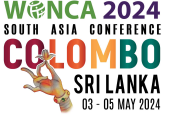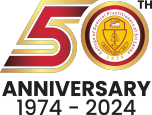 |
 |
||
|
WONCA South Asia Region Conference 2024 in conjunction with Golden Jubilee Celebrations of the College of General Practitioners of Sri Lanka "Celebrating Family Medicine - Nurturing Our Values across the Region" |
|||
 |
 |
||
|
WONCA South Asia Region Conference 2024 in conjunction with Golden Jubilee Celebrations of the College of General Practitioners of Sri Lanka "Celebrating Family Medicine - Nurturing Our Values across the Region" |
|||
 |
WONCA South Asia Region Conference 2024 in conjunction with Golden Jubilee Celebrations of the College of General Practitioners of Sri Lanka "Celebrating Family Medicine - Nurturing Our Values across the Region" |
 |
||
Set in the Indian Ocean in South Asia, the tropical island nation of
Sri Lanka has a history dating back to the birth of time. It is a
place where the original soul of Buddhism still flourishes and where
nature's beauty remains abundant and unspoilt.
Few places in the world can offer the traveller such a remarkable
combination of stunning landscapes, pristine beaches, captivating
cultural heritage and unique experiences within such a compact
location. Within a mere area of 65,610 kilometres lie 8 UNESCO World
Heritage Sites, 1,330 kilometres of coastline - much of it is
pristine beach - 15 national parks showcasing an abundance of
wildlife, nearly 500,000 acres of lush tea estates, 250 acres of
botanical gardens, 350 waterfalls, 25,000 water bodies, to a culture
that extends back to over 2,500 years.
This is an island of magical proportions, once known as Serendib,
Taprobana, the Pearl of the Indian Ocean, and Ceylon.
Discover refreshingly Sri Lanka!
| Official Name | Democratic Socialist Republic of Sri Lanka |
| Government Type | Republic |
| Location | Latitude 5° 55. to 9° 50. north, Longitude 79° 42. to 81° 52., 650km north of the equator |
| Dimensions | 430km North to South, 225km East to West |
| Coastline | 1,340km |
| Area | 65,525km |
| Currency (code) | Sri Lankan Rupee (LKR) |
| Independence | 4 February 1948 |
| Administrative Capital | Sri Jayewardenepura |
| Commercial Capital | Colombo |
| Terrain | Mostly low, flat to rolling plain; mountains in south-central interior |
| Highest Mountain | Pidurutalagala, 2,524m |
| Highest Waterfall | Bambarakanda, 263m |
| National Flower | The Blue Water Lily (Nymphaea stellata) |
| Population | 20,359,439 |
| Life Expectancy at Birth | 78.6-Female,72-Male |
| Literacy Rate | Female 90.8,Male 92.77 |
| Ethnic Groups | Sinhala (74.9%), Sri Lanka Tamil (11.2%) , Moor (9.3%) , Indian Tamil (4.1%) (2012 census) |
| Languages | Sinhala (official and national language) 74%, Tamil (national
language) 18%, other 8% Note: English (a link language commonly) is used in government and spoken competently by about 10% of the population |
| Religion | 70.1% of Sri Lankans were Theravada Buddhists, 12.6% were Hindus, 9.7% were Muslims (mainly Sunni), 6.2% Roman Catholic, 1.4 other Christians and 0.05% others.(2012 Census) |
| Time Zone | Sri Lanka Standard Time is five and a half hours ahead of GMT. (Allowance should be made for summer-time changes in Europe.) |
| IDD Code | +94 |
| Electricity . | 230 - 240 volts, 50 cycles AC |
Sri Lanka has excellent air connectivity with direct flights from
various international destinations. The Bandaranaike International
Airport (Colombo Airport), situate 35km noth of Colombo is the main
international airport.
As the Official Airline Partner of the WONCA South Asia Region Conference 2024 Sri Lankan
Airlines would offer all participants and accompanying persons a 15
% discount on economy class airfare and a 10% discount on business
class airfare (on the prevailing market fare at the time of
ticketing) for purchase of tickets for registered delegates
travelling to Sri Lanka from all online stations.
Launched in 1979, SriLankan, member of the 'One world' alliance, is
Sri Lanka's national carrier. It has a solid reputation for inflight
service.
Operating from Bandaranaike International Airport in Colombo, it
provides convenient connections to its global route network of 112
destinations in 58 countries.
As the Official Airline Partner of the WONCA South Asia Region Conference 2024 Sri Lankan
Airlines would offer all participants and accompanying persons a 15
% discount on economy class airfare and a 10% discount on business
class airfare (on the prevailing market fare at the time of
ticketing) for purchase of tickets for registered delegates
travelling to Sri Lanka from all online stations.
Sri Lankan Airlines on-line stations
| Indian Sub-Continent
|
. | Far East
|
. | Europe
|
| Bangalore Chennai Dhaka Gan Island Hyderabad Karachi Kathmandu Kochi Lahore Madurai Male Mumbai New Delhi Tiruchirappalli Trivandrum |
Bangkok Beijing Guangzhou Jakarta Kuala Lumpur Melbourne Seoul Shanghai Singapore Sydney Tokyo |
Frankfurt London Paris |
All foreign participants who attend the conference should obtain an Electronic Travel Authorization before entering Sri Lanka. The visa will be issued under Business Visa – Standard Visitor Visa category for persons participating in Seminars, Conferences and Workshops.
ETA applications could be submitted using one of the following
methods;
• Online through the official ETA portal of Sri Lanka prior to
travel
• At a Sri Lanka Mission overseas prior to travel
• On arrival at the Airport
It is strongly advised that participants obtain the ETA prior to
travel to avoid potential delays at the airport. The online ETA
portal is considered reliable, efficient and user friendly.
APPLY VISA ONLINE
https://www.srilankaevisa.lk
A visitor is allowed to bring into the country duty free 1.5 litres
of spirits, two bottles of wine, a quarter-litre of toilet water,
and a small quantity of perfume and souvenirs with a value not
exceeding US $250. The import of personal equipment such as cameras
and laptop computers is allowed but must be declared on arrival.
However, personal equipment must be taken out of the country upon
the visitor's departure.
The import of non-prescription drugs and pornography of any form is
an offence.
Sri Lank Offers visitors an excellent range of accommodation
facilities to suit all budgets from luxury hotels to low budget
accommodations.
The organizers have negotiated special rates applicable to
conference participants with Official Hotels. Return shuttle
transfers will be provided from official hotels to the conference
venue for the participants who make reservations at official hotels
through the Conference Secretariat.
There are no restrictions on the amount of foreign currency that can
be brought into Sri Lanka. However, if the value of the currency
exceeds USD 10,000 or its equivalent, it must be declared upon
arrival.
Visitors are allowed to take out the unspent portion of the foreign
currency they brought into Sri Lanka. Unspent rupees converted from
foreign currencies also can be re-converted to the original currency
on departure as long as encashment receipts can be produced.
The local currency is the Sri Lankan Rupee, divided into 100 cents
(you rarely come across cents today). Currency notes are Rs. 5,000,
Rs. 2,000, Rs. 1,000, Rs. 500, Rs. 100, Rs. 50 and Rs.20.
Beware of mistaking the Rs. 500 note for the somewhat similar Rs.
100 one. To check whether notes are genuine when not given at a
bank, look for a lion watermark. Coins, should you have received
them, will be in denominations up to Rs. 10.
Sri Lanka Standard Time is five and a half hours ahead of GMT.
(Allowance should be made for summer-time changes in Europe.)
The standard voltage of electricity in Sri Lanka is 230 volts and
operates on a 50Hz frequency.
Type G plug, also known as the British BS-1363 plug, is the standard
electrical plug used in Sri Lanka. The Type G plug has three
rectangular-shaped pins in a triangular pattern and is designed to
operate at a voltage of 230 volts and a frequency of 50 Hz.
Most hotels, restaurants and shopping centres accept credit cards.
Banks are open from 0900 hrs to 1500 hrs, Monday to Friday.
It is easy to withdraw money across the island at ATMs using
international credit cards or debit cards.
Sri Lanka has two official languages. Sinhala and Tamil - with
English as a link language. Most people have some knowledge of
English, and signboards are often in English.
Due to the location of Sri Lanka, within the tropics between 5o 55'
to 9o 51' North latitude and between 79o 42' to 81o 53' East
longitude, the climate of the island could be characterized as
tropical.
The central part of the southern half of the island is mountainous
with heights more than 2.5 Km. The core regions of the central
highlands contain many complex topographical features such as
ridges, peaks, plateaus, basins, valleys and escarpments. The
remainder of the island is practically flat except for several small
hills that rise abruptly in the lowlands. These topographical
features strongly affect the spatial patterns of winds, seasonal
rainfall, temperature, relative humidity and other climatic
elements, particularly during the monsoon season.
The Climate of Sri Lanka is dominated by the above-mentioned
topographical features of the country and the Southwest and
Northeast monsoons regional scale wind regimes. The Climate
experienced during 12 months period in Sri Lanka can be
characterized in to 4 climate seasons as follows.
1. First Inter-Monsoon Season - March - April
2. Southwest Monsoon Season - May - September
3. Second Inter-Monsoon Season - October - November
4. Northeast Monsoon Season - December - February
Sri Lanka is a round-the-year destination for the visitors who seek
for sun and sea and the best time to visit the island is considered
from November to April.
Sri Lanka has a tropical climate, so it is recommended to wear
lightweight and breathable fabrics such as cotton or linen to stay
cool and comfortable in the hot and humid weather.
When visiting temples, mosques, or other religious sites, it is
important to dress modestly and remove footwear before entering.
Long pants or skirts and shirts that cover the shoulders are
typically appropriate.
Sri Lanka is a tremendously photogenic island. The stunning
landscapes, the captivating fauna and lush flora, and the stupendous
archaeological remains provide great opportunities: a bonus is that
Sri Lankans love to be captured on camera.
Permits
Tourists who wish to visit and or photograph the principal ancient
monuments in Sri Lanka are required to purchase a ticket at the
site.
Restrictions
There are some important restrictions that apply to photography in
religious places. When you visit a temple or other religious site,
remember that photography should not be carried out in a manner
causing disrespect. For instance, it is strictly forbidden to be
photographed in front of or beside any statues and murals. Flash
photography should not be carried out as it can damage old murals.
 |